This post may contain affiliate links. Please see our disclosure policy.
Fish chowder is a classic comfort food, and this simple pressure canning recipe allows you to cook a fish chowder base to save time on busy weeknights. Just warm, add cream, and serve!
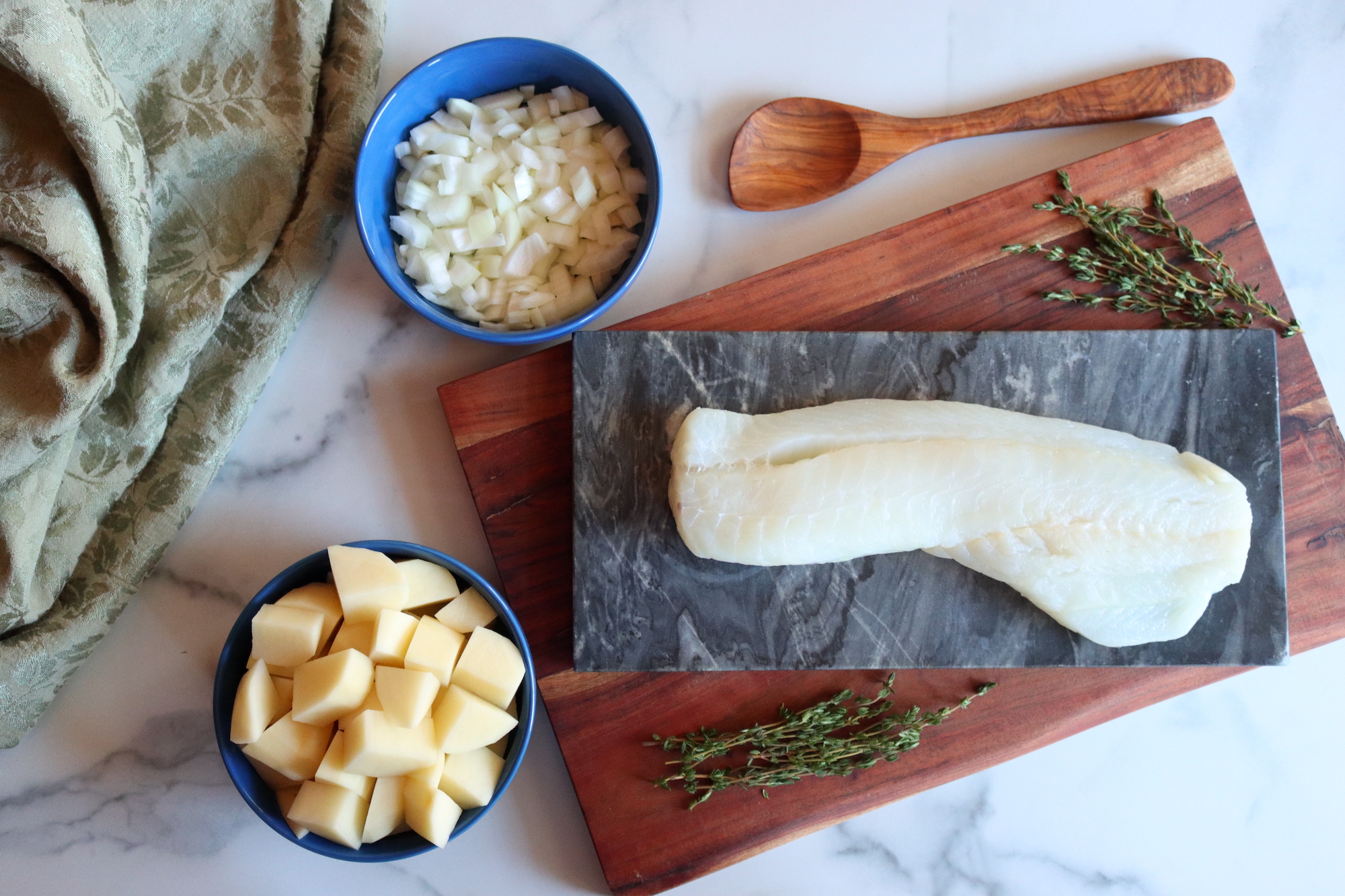
Have you ever dreamed of savoring a bowl of homemade fish chowder without having to spend hours in the kitchen? Canning your own fish chowder base is the answer!
Fish chowder base is a concentrated mixture of ingredients that forms the foundation of a hearty fish chowder. By canning this base, you can quickly whip up a delicious bowl of chowder by simply adding a few fresh ingredients when you’re ready to eat.
It’s like having a gourmet meal at your fingertips, perfect for those busy weeknights or when you need to impress unexpected guests.
Whether you’re a home cook, an avid canner, a healthy eater, or just someone who wants to save a little time, this guide will show you how to make and can your very own fish chowder base. Get ready to enjoy delicious chowder anytime you like!
Ingredients for Fish Chowder Base
This recipe is based on the University of Alaska’s Hearty Soup canning protocol. That guidance allows you to create your own soup canning recipe, provided you use their specific guidelines, times, and pressures. The ingredients for canning fish chowder base are quite simple. To make a canner batch of six pints, you’ll need the following:
- 1 ½ lbs cod
- 3 cups potatoes, peeled and diced
- 2 cups onion, peeled and diced
- ½ cup white wine
- 4 cups stock (fish stock, chicken broth, or vegetable broth)
- 1 tsp thyme
- 2 teaspoon Old Bay (optional – you can use a little paprika and a dash of cayenne instead)
- 2 tsp salt
- ½ tsp garlic powder
Feel free to make substitutions where necessary. For instance, you can use another type of white fish instead of cod or vegetable broth instead of fish stock. While cod is the most popular choice you can substitute it with haddock, halibut, or any firm white fish. Just make sure the fish is fresh and of high quality.
The key is to maintain the balance of flavors by respecting the ratios and quantities above and to make sure the ingredients are fresh and high-quality.
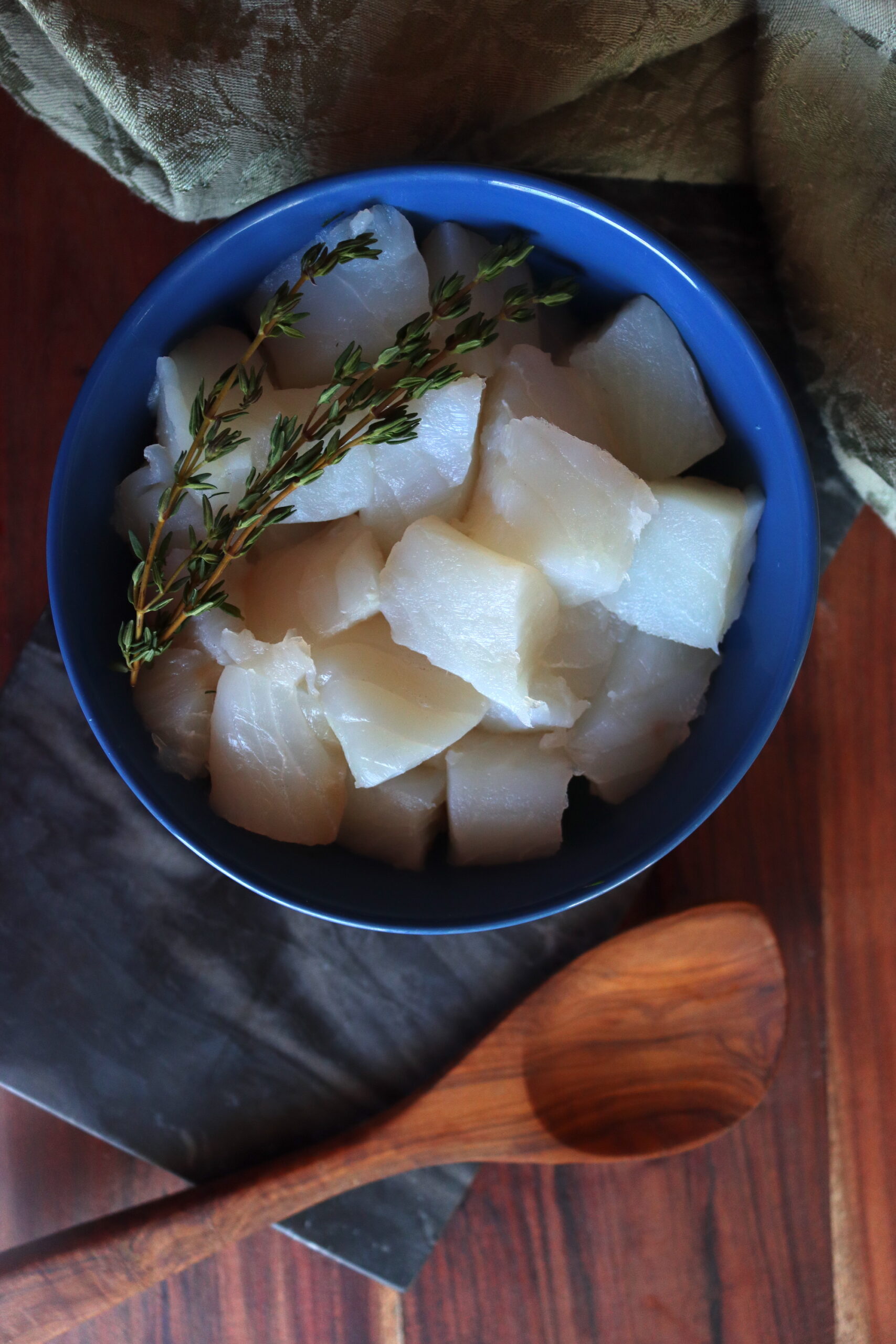
Canning Fish Chowder Base
Cut the cod into bite-sized pieces. Don’t worry if there are some bones – they will soften during the canning process. Dice the potatoes and chop the onions into small, uniform pieces to guarantee even cooking.
Then, measure out the white wine and stock. These liquids will meld the flavors together and create a rich base. Gather your thyme, Old Bay seasoning, salt, and garlic powder. Remember, the flavors will intensify during the canning process (except for garlic, which tends to mellow out), so don’t overdo it.
Combine all the prepared ingredients in a large pan. Cover them with hot water, broth, or wine. Bring the mixture to a boil and cook for five minutes. Fill your hot, clean canning jars with the mixture, leaving one inch of headspace. This space is crucial for proper sealing and preventing overflow during processing.
Heat the canner and allow it to vent steam for 10 minutes before adding your weight. Process the filled jars in a pressure canner for 100 minutes at 11 lbs pressure (dial gauge canner) or 10 lbs pressure (weighted gauge canner). Adjust for altitude as needed. Remember, if the canning pressure goes below the specified level, you need to restart your timer to make sure everything processes up correctly.
After the timer goes off, turn the heat off and leave your pressure canner in place. Do not remove the lid. Allow it to depressurize on its own, then wait an additional ten minutes. Remove the lid and jars, then allow them to cool on the counter for 24 hours. Check each jar to ensure a proper seal. If any jars don’t seal correctly, refrigerate and use them within a few days.
Otherwise, label your jars with the date and contents before storing them in a cool, dark place. Properly canned chowder base can last up to a year.
Altitude Adjustments
With pressure canning, the processing times stay the same at higher altitudes, but the pressures change. Here are the altitude adjustments for pressure-canning Fish Chowder Base:
For dial gauge pressure canners:
- 0 to 2,000 feet in elevation – 11 lbs pressure
- 2,001 to 4,000 feet in elevation – 12 lbs pressure
- 4,001 to 6,000 feet in elevation – 13 lbs pressure
- 6,001 to 8,000 feet in elevation – 14 lbs pressure
For weighted gauge pressure canners:
- 0 to 1,000 feet in elevation – 10 lbs pressure
- Above 1,000 feet – 15 lbs pressure
Serving Fish Chowder Base
The best part about making fish chowder base is that it’s just as easy to serve as it is tasty! All you need to do is heat the chowder base on the stove until it reaches the desired temperature. Then, you can add any other ingredients you’d like for a desired recipe.
Here are some suggestions:
- Classic Fish Chowder: Add clams, shrimp, or lobster for a hearty seafood chowder.
- Corn and Fish Chowder: Stir in some fresh or frozen corn kernels and diced bell peppers.
- Potato and Leek Chowder: Include finely sliced leeks and extra diced potatoes for a thicker, creamier chowder.
- Spicy Fish Stew: Enhance with chopped tomatoes, green chilies, and a splash of hot sauce for a spicier version.
- Creamy Mushroom and Fish Chowder: Mix in sautéed mushrooms and a dash of heavy cream.
- Fish and Vegetable Chowder: Add diced carrots, celery, and green beans for a nutritious take.
- Smoked Fish Chowder: Use smoked fish in addition to the cod for a rich and smoky flavor.
- Thai-style Fish Soup: Incorporate coconut milk, lime juice, and a touch of red curry paste for an exotic twist.
Or, for a creamy, indulgent chowder, stir in some cream and sprinkle with fresh dill. This adds richness and a burst of freshness that elevates the flavor.
As for what to serve it with, you can pair your chowder with a slice of crusty bread or a warm roll. It’s perfect for soaking up every last drop of the delicious broth.
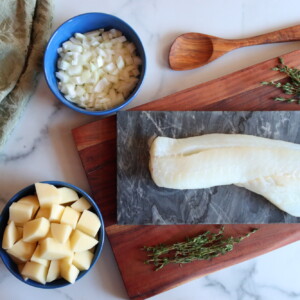
Canning Fish Chowder Base
Equipment
Ingredients
- 1 ½ lbs cod
- 3 cups potatoes
- 2 cups onion
- ½ cup white wine
- 4 cups stock
- 1 tsp thyme
- 2 tsp Old Bay, optional – you can use a little paprika and a dash of cayenne instead
- 2 tsp salt
- ½ tsp garlic powder
- 4 oz salt pork, optional, add after canning for serving only
Instructions
- Cut cod into bite-sized pieces.
- Dice potatoes and chop onions.
- Combine all ingredients in a large pan and cover with hot water, broth, or wine. Boil for five minutes.
- Fill hot, clean canning jars with the mixture, leaving one inch of headspace.
- Process pints for 100 minutes at 11 lbs pressure (dial gauge canner) or 10 lbs pressure (weighted gauge canner), adjusting pressure to altitude (see notes).
Notes
Altitude Adjustments
With pressure canning, the processing times stay the same at higher altitudes, but the pressures change. Here are the altitude adjustments for pressure-canning fish chowder base:For dial gauge pressure canners:
- 0 to 2,000 feet in elevation – 11 lbs pressure
- 2,001 to 4,000 feet in elevation – 12 lbs pressure
- 4,001 to 6,000 feet in elevation – 13 lbs pressure
- 6,001 to 8,000 feet in elevation – 14 lbs pressure
For weighted gauge pressure canners:
- 0 to 1,000 feet in elevation – 10 lbs pressure
- Above 1,000 feet – 15 lbs pressure
Nutrition
Nutrition information is automatically calculated, so should only be used as an approximation.
Fish and Seafood Canning Recipes
Fish chowder base is a versatile starting point for hearty meals! Pair it with other seafood recipes like Canning Salmon Chowder Base or the rich flavors of Canning Nordic Salmon Soup. For more variety, try Canning Tuna or Canning Shrimp, both of which make excellent additions to chowders.
Explore even more options in 12+ Fish Canning Recipes, including crab and salmon.
Soup Canning Recipes
Looking for more easy homemade soup-in-a-jar canning recipes?
- Canning Carrot Soup
- Canning Split Pea Soup
- Canning Sausage, Potato and Kale Soup
- Canning Chicken Soup

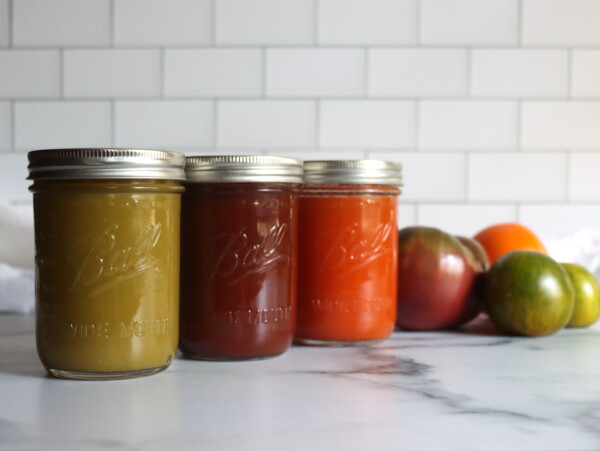
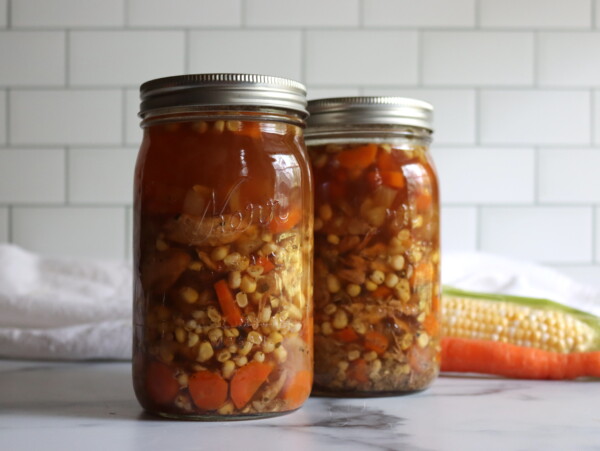
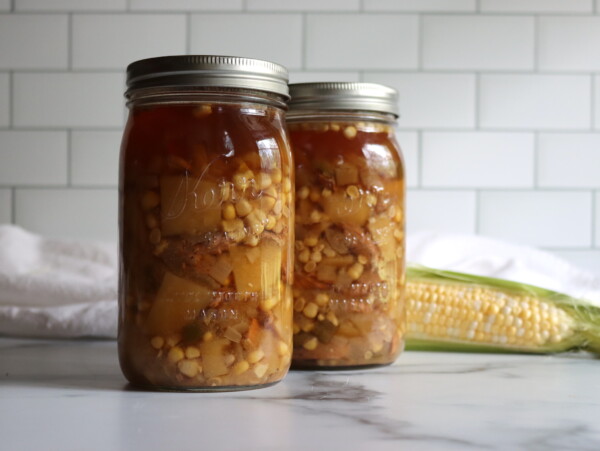
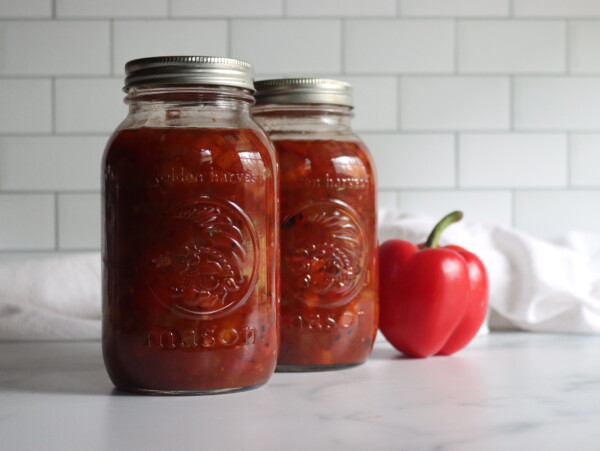
Hello I was under the impression that coconut milk could not be added for the canning process but could be added when heated up to eat. Does this hold true in this case? I’m interested in making the thai fish.
recipe. Can I add the curry sauce to process or do i have to add that when i heat to eat also?
That is correct. Coconut milk can only be added at serving, but not in the canning process. For the Thai curry paste, that’s a seasoning, and is fine for adding into the canning jar in pressure canning recipes.